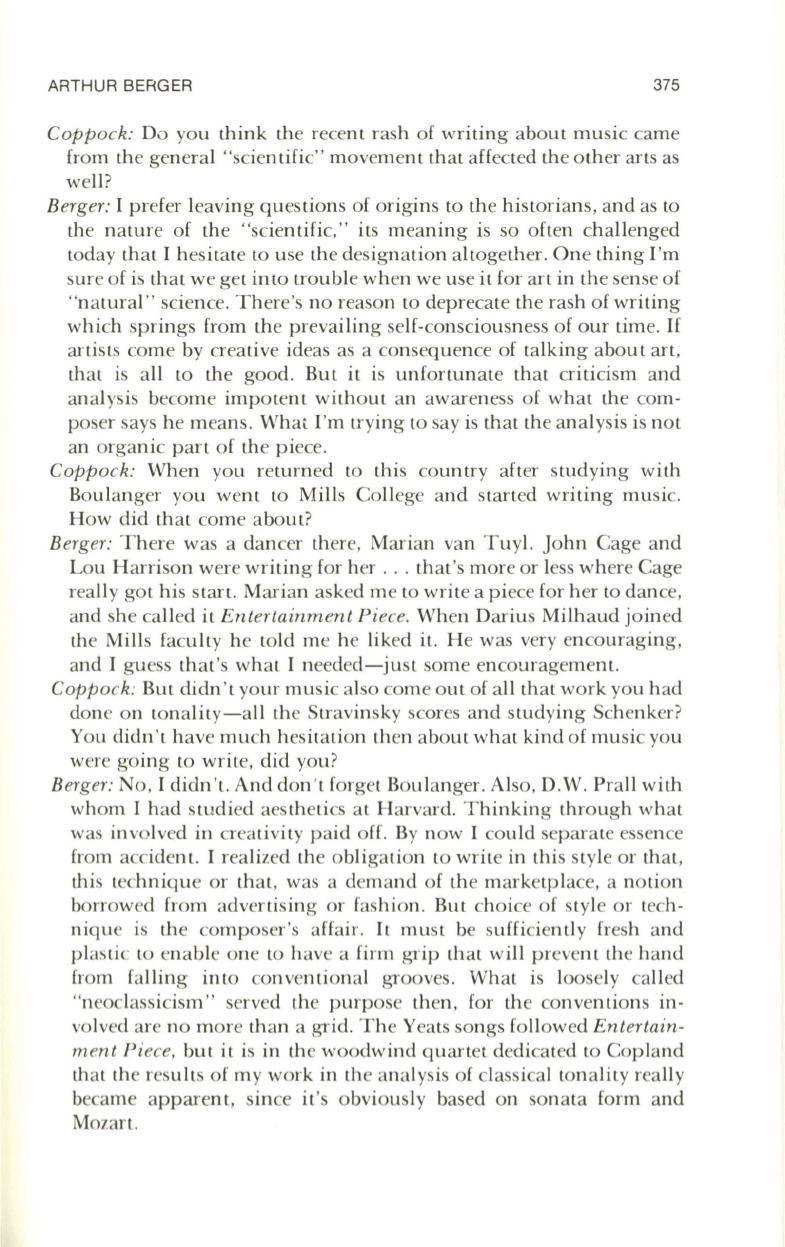
ARTHUR BERGER
375
Coppock:
Do you think the recent rash of writing about music came
from the gen eral "scientifi c" movement tha t affected the o ther arts as
we ll ?
Berger:
I prefer leaving ques tions of orig ins to the historians, and as to
the nature of the "scientific," its meaning is so often ch allenged
today tha t I hes ita te to use the des ign ation altogether. One thing I 'm
su re o f is tha t we ge t into troubl e when we use it for art in the sen se o f
"na tural " scien ce. There's no reason to deprecate the rash of writing
which springs from the prevailing self-consciousness of our time.
If
ar ti sts come by creative ideas as a consequ en ce of talking about art,
thal is all to the good. But il is unfor tuna te that criticism and
analys is become impo tent without an awareness of what the com–
poser says he mean s. What I'm trying to say is tha t the an alys is is no t
an organi c par t o f the piece.
Coppock:
When you returned to this country after studying with
Boulanger you went to Mills Coll ege and started writing music.
How did tha t come about?
Berger:
There was a dancer there, Mar ian van Tu yl. John Cage and
Lou H arr ison were writin g for her ... that 's more or less where Cage
rea ll y go t his start. Mar ian as ked me to write a piece for her to dance,
and sh e call ed it
Entertainment Piece.
When Darius Milhaud jo ined
the Mills faculty he to ld me he liked it. He was very encouraging,
and I guess that 's wha t I needed-just some en couragement.
Coppock:
But didn 't your music also come out of all tha t work you h ad
done on tonality- a ll the Stravinsky scores and studying Schenker?
You didn 't have much hes itation then about what kind o f mu sic you
were going to write, did you?
Berger:
No, I didn 't. And don 't forget Bo ul anger. Also, D.W. Prall with
whom I had s tudied aes thetics a t H arvard. Thinking through what
was in volved in crea ti vity p aid off . By now I could separate essence
from acciden t. I realized the o bligation to write in this style or tha t,
thi s technique or tha t, was a demand of the marketplace, a no tion
borrowed from advertising or fashi on. But choice o f style or tech–
nique is the composer 's affair.
It
must be sufficientl y fresh and
plas ti c to en able one to h ave a firm gr ip th at will prevent the hand
from falling into con venti onal grooves. What is loosely call ed
"neoclass icism " served the purpose then , for the conventions in–
volved are no more than a grid. The Yeats songs followed
Entertain–
m ent Piece,
but it is in the woodwind quartet dedi ca ted to Copland
tha t the results of my work in the analys is of class ical ton ality rea ll y
became apparent, since it's o bviously based on sona ta form and
Mozart.


